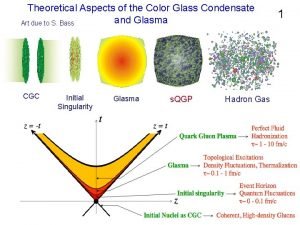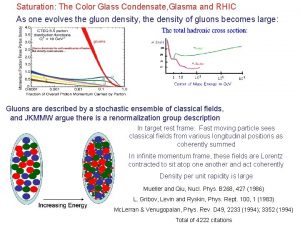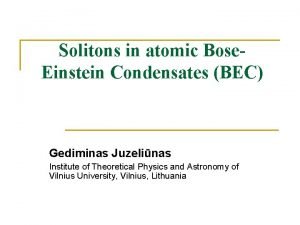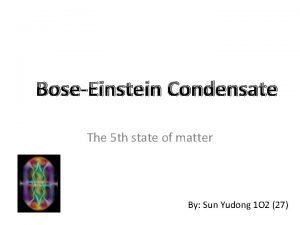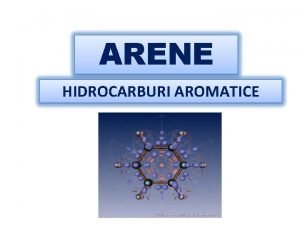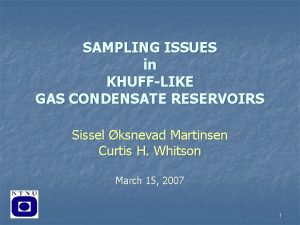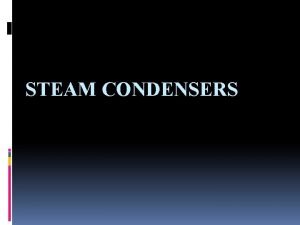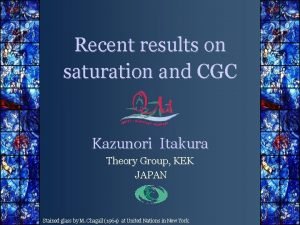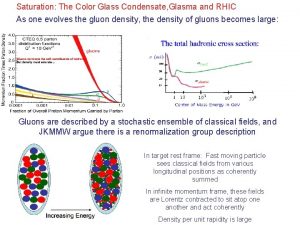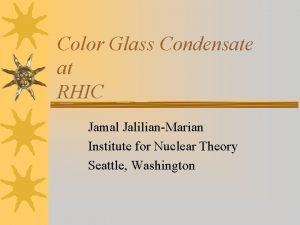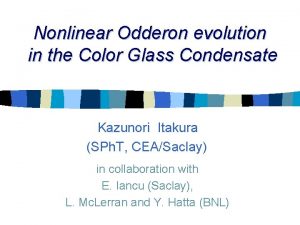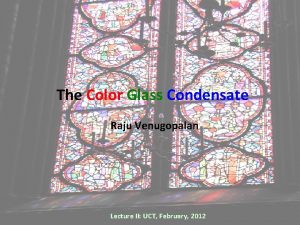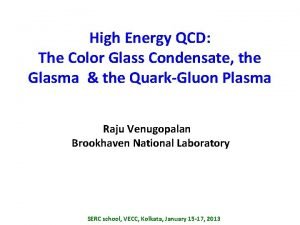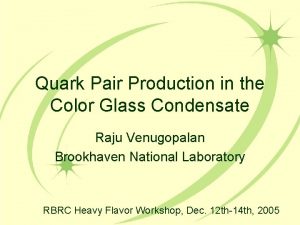Color Glass Condensate and UHECR physics Kazunori Itakura















- Slides: 15

Color Glass Condensate and UHECR physics Kazunori Itakura KEK, Japan SOCo. R @ Trondheim Background photo: “deformation of a polyethylene folio” by Zdenka Jenikova 2002

Contents • What is the CGC, and why? • Facts about the CGC • Comparison with the existing EAS models • Possible application of the CGC to CR physics

What is the CGC? • Dense gluonic states in hadrons which universally appear in the high-energy limit of scattering Color … gluons have “colors” Glass … gluons with small longitudinal fractions (x <<1) are created by long-lived partons that are distributed randomly on the transverse disk Condensate … gluon density is very high, and saturated High energy Color Glass Condensate (CGC) • Most advanced (and still developing) theoretical picture of high energy scattering in QCD Based on QCD (weak coupling due to Qs >> LQCD , but non-perturbative ) Unitarity effects (multiple scattering, nonlinear effects) LO description completed around 2000

Why CGC? Indispensable for correct understanding of CR physics Primary collision proton-Air collision at extremely large energy projectile (proton/nucleus) A 1 x 1, x 2 : longitudinal momentum fractions pt : transverse momentum of produced hadrons target (light nucleus) A 2 h : rapidity h > 0 forward direction Forward scattering h > 0 x 1 is large ~ 1 (valence) but x 2 is extremely small Cf: the smallest value in colliders x ~10 -6 (HERA)

Do we really need hard physics? Example: typical “mini-jet” models increase of cross section is explained by increasing hard (mini-jet) contributions hard contr. pp, ppbar charged particle multiplicity X. N. Wang, Phys. Rep. 280 (1997) 287 pp, ppbar total cross sections A. Achilli, et al. PLB 659 (2008) 137 Unitary, but no effects of “true” saturation/CGC (coherent scattering) eikonalization = sum of multiple independent scattering we expect hard (and semi-hard) components are important

Proton composition changes with energy Deep inelastic scattering (ep e. X) can probe quarks and gluons in a proton g* transverse longitudinal partons 1/Q 1/x. P+ Gluons (must be multiplied by 20) Q 2 : transverse resolution x : longitudinal fraction Gluons are the dominant component at high energy (small x) longitudinal fraction x higher energies

Recombination of gluons Qs-1 is typical transverse size. QS 2(x) ~ 1/xl increases (x 0) Color glass condensate as(QS 2) << 1 weak coupling Nonperturbative region Higher energies Phase diagram of a proton as seen in DIS ale c s n (x) Qs tio ra Satu BK log scale Multiple gluon emissions Gluon density low unitarity 1/x in high Parton gas BFKL DGLAP LQCD 2 Q 2 in. Parton log number scale increases, but density decreases Transverse resolution

Facts about the CGC 2009 Nonlinear evolution equations (govern energy dependence of Xsecs) LO (as ln 1/x)n : Balitsky-Kovchegov equation (1996) Dipole scatt. amp NLO as (as ln 1/x)n : completed by Balitsky and Chirilli (2008) running coupling effects (necessary for “long” evolution from low to high energies)

Facts about the CGC 2009 Saturation scale depends on rapidity (y=ln 1/x) and atomic mass number A Can be determined by LINEAR evolution equations (LO, resummed NLO BFKL ) Fixed coupling Qs grows exponentially and works at HERA and RHIC energies Exponent l is consistent with resummed NLO BFKL (2003) but should be taken over by running coupling Qs showing milder growth Evidences in collider experiments (HERA, RHIC) Geometric scaling (ep & e. A DIS, diffractive DIS) existence of Qs 2001 ~ 2006 extends outside of the saturation regime kt < Qs 2/LQCD new wide window “extended scaling regime” (Iancu-KI-Mc. Lerran, 2003) Suppression of particle production at forward rapidity in d. Au collision (RHIC 2004) Enhancement (Cronin effect) at mid-rapidity can also be understood.

Geometric Scaling DIS (ep, e. A) cross sections scale with Q 2/Qs 2 Stasto, Golec-Biernat, Kwiecinski PRL 86 (2001) 596 ep Freund, Rummukainen, Weigert, Schafer PRL 90 (2003) 222002 e. A Marquet, Schoeffel Phys. Lett. B 639 (2006) 471 Diffractive ep g*p total Q 2/Qs 2(x) Q 2/Qs 2(x, A) • Existence of saturation scale Qs • Can determine x and A dependences of Qs • Extends outside of the saturation regime kt < Qs 2/LQCD Q 2/Qs 2(x. P)

How about existing EAS models? Correct recognition for the importance of saturation T. Stanev, “High Energy Cosmic Rays” (2004), p 208 When the parton density (at low x values and high energy) reaches a very high value, the individual partons cannot see each other and thus interact; they are obscured by intervening particles. This is obvious in the simple geometrical definition of a cross-section, but certainly also happens in the real world. Existing models are supposed to include “effects of saturation” Sibyll 2. x : hard part is given by mini-jet model d. N/dkt 2 with an “energy dependent” cutoff similar to Qs(x) with running coupling (x~1/s) QGSJET II: Pomeron-pomeron interaction (nonlinear effects) 1/kt 2 But, in Sibyll, particles below the cutoff (p < pmin) are absorbed into soft part and in QGSJETII, only soft Pomeron interactions were included. “semi-hard” contributions (LQCD<pt< Qs) are missing!! main part of the CGC physics kt 2

Higher energies So, what should be done? CGC Non-perturbative (Regge) 1/x QS 2(x) Extended scaling regime LQCD 2 QS 4(x)/LQCD 2 d. N/dkt 2 CGC scaling regime p. QCD (minijet) Parton gas Q 2 Transverse resolution LQCD 2 QS 2(x) QS 4(x)/LQCD 2 Most of gluons have momenta around Qs !! Need to include “CGC+scaling regime” in between soft (Regge) and hard (minijet) kt 2

Some attempts Modification of the minijet model F. Carvalho, et al. ar. Xiv: 0705. 1842 v 1 Use IIM (Iancu-Itakura-Munier) parametrization Problems matching procedure (dijet vs monojet) impact parameter dependence (black disk expansion) running coupling effects (included in v 2) M. F. Cheung, C. Chiu, and K. Itakura, work in progress BBL model H. Drescher, A. Dumitru, and M. Strikman, PRL 94 (2005) 231801. use a simple model to calculate cross section - Mc. Lerran-Venugopalan model for quark scattering - kt factorized cross section for gluon production too naïve application of CGC (no impact parameter dep. etc) need improvement

Problems still to be clarified Impact parameter dependence Not precisely known (non-perturbative) high energy behavior of cross section # A simple “assumption” eg: exp{ –b/2 mp} leads to (Ferreiro, Iancu, KI, Mc. Lerran, 2002) black disk expansion (dipole-CGC scattering) consistent with the Froissart bound # Still need to put IR regulator for the gluon propagators # Can be (somewhat) determined from ds/dt , scaling with Qs(y, A, b)? Energy conservation # BFKL pomeron is not energy conserved. problem for realistic simulation Need to include the effects of energy conservation (Avsar et al. 2005)

Summary • High energy hadron scattering is described by the “Color Glass Condensate (CGC)” which is a dense gluonic state. • Its theoretical framework is established up to “leading-order” except for the impact parameter dependence which includes non-perturbative physics. “Next-leading-order” analysis has just started. • The kinematical region for the CGC expands with increasing energy, and thus we naively expect the CGC will be important at CR energies. • Why don’t you consider the CGC in CR physics?
 Color glass condensate
Color glass condensate Color glass condensate
Color glass condensate Kazunori kataoka
Kazunori kataoka State of matter
State of matter Plasma and bose-einstein condensate
Plasma and bose-einstein condensate Soliton
Soliton Facts about bose einstein condensate
Facts about bose einstein condensate Arenele sunt hidrocarburi
Arenele sunt hidrocarburi Halogenarea benzenului
Halogenarea benzenului Sprinkler pipe size chart
Sprinkler pipe size chart Khuff condensate
Khuff condensate In shell and tube surface condenser
In shell and tube surface condenser Condensate blockage
Condensate blockage Glass escalator concept
Glass escalator concept True or false hot glass looks the same as cold glass.
True or false hot glass looks the same as cold glass. Does hot glass look like cold glass
Does hot glass look like cold glass
